The work proposes Inter-Symbol Interference (ISI) reduction scheme, ISI being a major problem in Optical systems, which produces various type of non-linear distortions. So the implementation of OFDM system using Artificial Neural Network (ANN) scheme with M-QAM modulation technique is proposed and compared with the conventional OFDM system without using ANN. This proposed scheme is implementation of Back-propagation (BP) algorithm over AWGN channels to achieve an effective ISI reduction in orthogonal frequency division multiplexing (OFDM) systems. Simulation results prove that ANN equalizer can further reduce ISI effectively and provide acceptable BER and better MSE plot compared to conventional OFDM system.
Keywords: OFDM, artificial neural network, FFT, QAM, BER, ISI, MMSE
OFDM facilitates the possible growth of wireless communication for high quality multimedia services, high speed internet access, as well as data, video and voice transmission at higher rates. This multi-carrier modulation technique is limited to 4G mobile communication; it will also be implemented in the 5G communication system.1 It also provides a possible solution to multipath frequency selective fading effect. However, the problem of ISI occurs due to causes of multipath propagation, dispersive, noisy and fading channels present in the original signal in OFDM system. If the ISI is not mitigated properly, then decision device may interpret the logic wrongly.2 In this paper, ANN is proposed and is implemented after decoder of an OFDM system and this approach minimizes the error. Further, this proposed technique is compared to conventional ISI reduction techniques. The paper constitutes: Section II, which deals with relevant literature; Section III proposed, OFDM system description; ISI system model; Section IV explains about proposed methodology; Section V gives simulation setup and results; Section VI highlights conclusions and future scopes and Section VII presents references.
In3 author illustrated the performance of OFDM system by the use of low symbol rate, long symbol duration of the modulation scheme as well as use of guard bands for the reduction of ISI. In4 author proposed V-BLAST, Decision feedback signal detection method of cancellation of ISI and cyclic reconstruction method for the ICI removal purpose. In6 author proposed zero insertion (ZI) which insert zeros and each OFDM frames contain the same length. It also compares different guard interval (cyclic prefix, zero padding and known symbol padding) insertion techniques and shows that the ZI approach reduces the transmission rate, distortion in the channel as well as a 20% data reduction in the redundant data as compared to CP. In7 proposed zero-forcing equalizer which used longer filter span to compensate for the multipath channel distortion. In8 highlighted CP and ZP effect on the BER and give better performance under Rayleigh fading channel as compared to AWGN. In9 presented a two-dimensional 9/12 modulation code to combat 2D ISI and achieve ~2Db gain as compared to without encoding modulation code. In10 proposed unique word (UW) sequence which improved bandwidth efficiency, 15% throughput, and spectral efficiency 17% as compared to CP but CP-OFDM give better BER than UW-OFDM system. In11 proposed two channel estimator in which MMSE estimator gives more complexity than the LS estimator but MMSE need low SNR and LS need high for better performance.
Basic OFDM system model
Any OFDM system consists of consider N subcarriers, suppose that the complex symbol
is the signal point from the modulation signal constellation, which is modulated on the nth subcarriers and the
is the transmitted signal which is defined in5 as follows:
Where
,
, is the interval of OFDM symbol,
Is the symbol data period. To synthesize the above OFDM signal in equation (1) use Inverse Fast Fourier transforms (IFFT) which samples the
signal with sample rate
After IFFT the original time domain symbolic signal
is given as below:
Where N is the FFT length and
Is the baseband data sequence. To reduce, the ISI5 inserted cyclic prefix which extends the duration of symbols and is given as:
Then fading channel with white Gaussian noise transmitted
Signal and calculated the received signal
in the form below:
Where,
is the response of impulse for selective fading channel and
is the AWGN. After that signal
will be transmitted without using CP is given as:
Inter-symbol interference (ISI)
In band limited region, when the number of pulses is transmitted in succession then these pulses will interfere with each other and hence receiver will not be interpret the transmitted logic. So the BER in the receiver will increase. We can visualize inter-symbol interference (ISI) effect in (Figure 1).
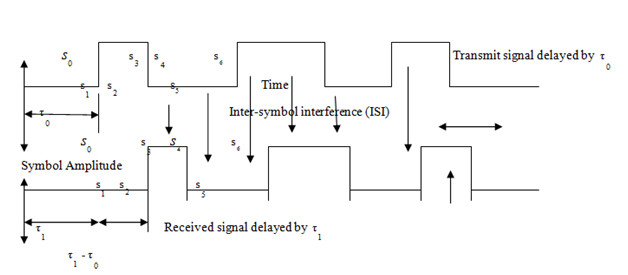
Figure 1 Inter-Symbol Interference (ISI) effect.
When
then different symbol creates interference with each other as shown in above figure where T is the symbol time, Is the transmitted signal delay and
Is the received signal delay.
. If
then this lead to inter-symbol interference (ISI) where
is the delay spread. ISI is undesirable since it leads to distortion of the original transmitted signal but if we can make
this implies no ISI.
The ISI channel has been described as:
Where
received symbol at time k,
transmitted symbol at time k,
is the previous transmitted symbol at k-1,
is the noise signal. The past symbol Interference with the present symbol
and introduce ISI.
Proposed methodology
In this work, we have proposed an artificial neural network combined technique, which provides ISI reduction in OFDM systems.
Proposed OFDM with ANN
The proposed OFDM with ANN scheme is given in below (Figure 1). Where 9600 information bits are randomly generated by using 96 bits single frame size and 100 total number of frames. Again convolution channel coder encodes the information bit by using the input\output size of the encoder, constraint length and specified poly2trellis (171,133] matrix and provide
coded data. Matrix interleaving, block is employed to further restrict the burst error developed during transmission. The output of the interleave is
coded output data is obtained. Further a data converter is available which convert the binary interleaving coded data into decimal format.
After that, M-QAM modulation scheme, the symbol values are generated. The proposed method provides better BER performance by (16, 64, and 256) QAM modulation schemes. This modulation value determines the number of bits (4, 6, and 8) per sub-carriers. Further, the pilot insertion concept introduced which adds data subcarrier values, 4 pilot symbols, and one DC subcarrier. Again, we take 64 points IFFT lengths which is equal to a number of carriers. The IFFT length, data subcarriers, pilot value and DC subcarrier also determine the guard band values. The 16 cyclic prefix lengths are inserted before the AWNG channel. CP means prefixing of symbols from the last part to front part. Here, the AWGN channel transmits original information data from transmitter to receiver. It adds some noise which destroy the signal. This can only be rectified by the use of ANN technique at the receiver side as shown in (Figure 2).

Figure 2 Block diagram of proposed (OFDM-ANN) technique.
Proposed Artificial Neural Network (ANN) Algorithm
The artificial neural network is implemented after Viterbi decoder block of an OFDM system that means it takes input from an OFDM system and output set as a target value. ANN is an artificial intelligence method used to enhance the capacity of computer by sending human like intelligence. This proposed work basically depends on back-propagation (BP) algorithm which sends signals in forward direction and propagate error in backward direction. The multilayer BP network is shown in (Figure 3). And the Log-Sigmoid function in12 is given as below:
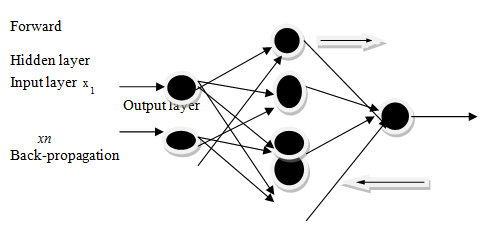
Figure 3 Multilayer back-propagation network.
(7)
(Figure 4) shows, the flow chart of ANN which give Error,
as the difference between the target (actual) value and expected value in9,13 as below:
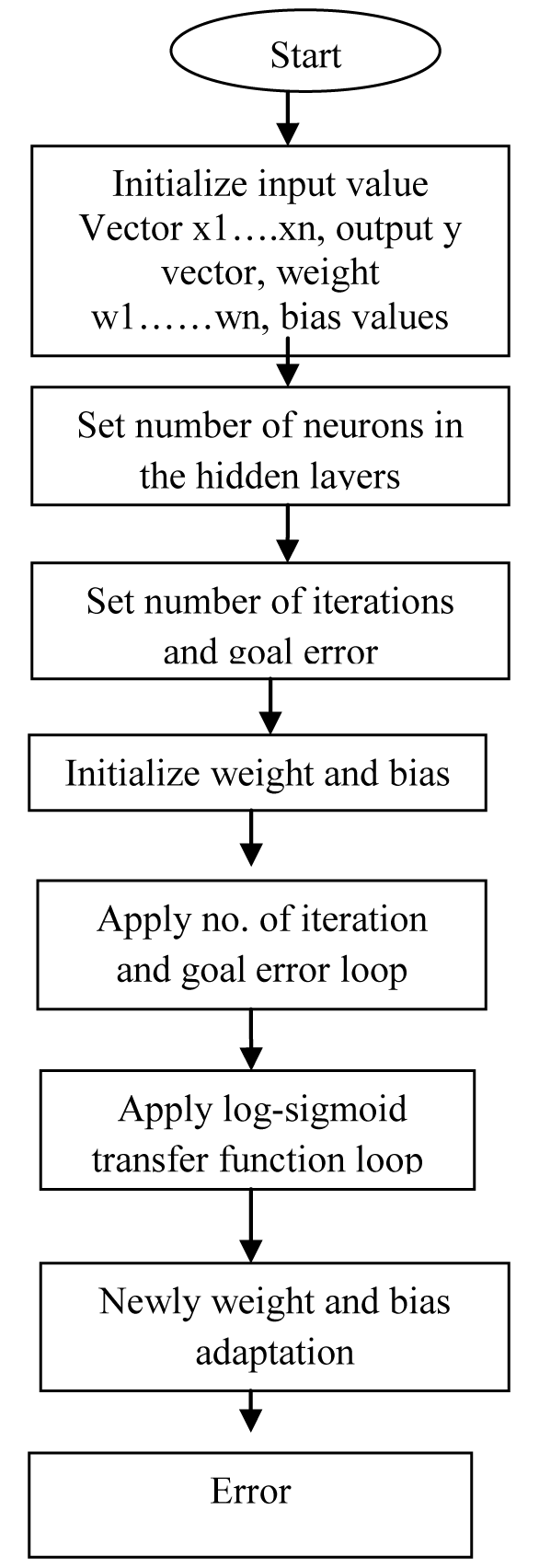
Figure 4 Flow chart of ANN algorithm.
(8)
Simulation setup and results
Simulation Setup
In this section, the simulation setup of an OFDM system is shown in (Table 1) & (Table 2) shows the simulation setup of an ANN which evaluates the BER, MSE performances of an OFDM system.
Parameter |
Value |
FFT size |
64 |
Number of carriers |
64 |
Single frame size |
96bits |
Total number of frames |
100 |
Cyclic-prefix |
16 |
Modulation |
16,64,256QAM |
Table 1 Parameters of OFDM system
Parameter |
Value |
Number of inputs |
2 |
Number of hidden layers |
1 |
Number of neurons |
90,1 |
Iteration |
1000 |
Goal error |
1.00E-06 |
Training function |
Back-Propagation |
Transfer function |
Log- Sigmoid |
Table 2 Parameters of artificial neural networks
Simulation results
- BER performances of OFDM systems with varying QAM Modulation schemes:
In (Figure 5), show the BER of conventional OFDM which gives better BER reduction performance for 16QAM modulation compared to 64 and 256 QAM modulation schemes.
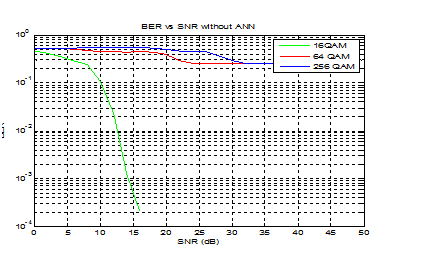
Figure 5 BER vs. SNR Graph without ANN.
- BER performances of Proposed OFDM Systems with varying M-QAM Modulation schemes:
In (Figure 6), show the BER of proposed OFDM, which give better BER reduction performance for 256QAM as compare to 16, 64 QAM modulation schemes.
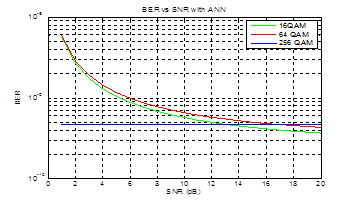
Figure 6 BER vs. SNR Graph with ANN.
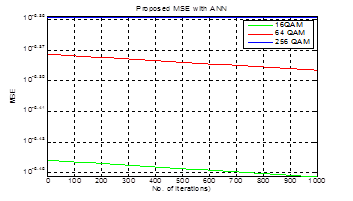
Figure 7 MSE vs. No. of iterations Graph with ANN.
(Table 3) shows the BER performance by varying signal to noise ratio. It shows that the OFDM-with-ANN provide BER approximate 10^=-9 and conventional OFDM require BER 10^-4.
Variation in M-QAM modulation |
BER for conventional OFDM |
BER for proposed OFDM |
16QAM |
0.0002 |
1.00E-09 |
64QAM |
0.25 |
1.00E-09 |
256QAM |
0.25 |
1.00E-09 |
Table 3 BER for Conventional and Proposed OFDM systems
- MSE performances of the Proposed OFDM Systems with varying QAM Modulation schemes
(Table 4) shows, MSE performance by varying the number of iterations. It shows that the Proposed OFDM by using M-QAM modulation require minimum MSE as compare to conventional OFDM without ANN.
MSE for M-QAM modulation |
Conventional OFDM |
Proposed OFDM |
16QAM |
0.05067 |
0.00000354 |
64QAM |
0.00301 |
0.00000412 |
256QAM |
0.49765 |
0.000004 |
Table 4 MSE for Conventional and Proposed OFDM systems
This paper proposed, Back-propagation (BP) based ANN channel estimator which is further combined with OFDM system. This proposed combined technique provides better ISI reduction performance than an OFDM system without adding ANN. In this work, ISI is directly proportional to BER and inversely proportional to SNR. The future scope of this paper is to apply ANN with MIMO-OFDM system or use of other modulation technique.


